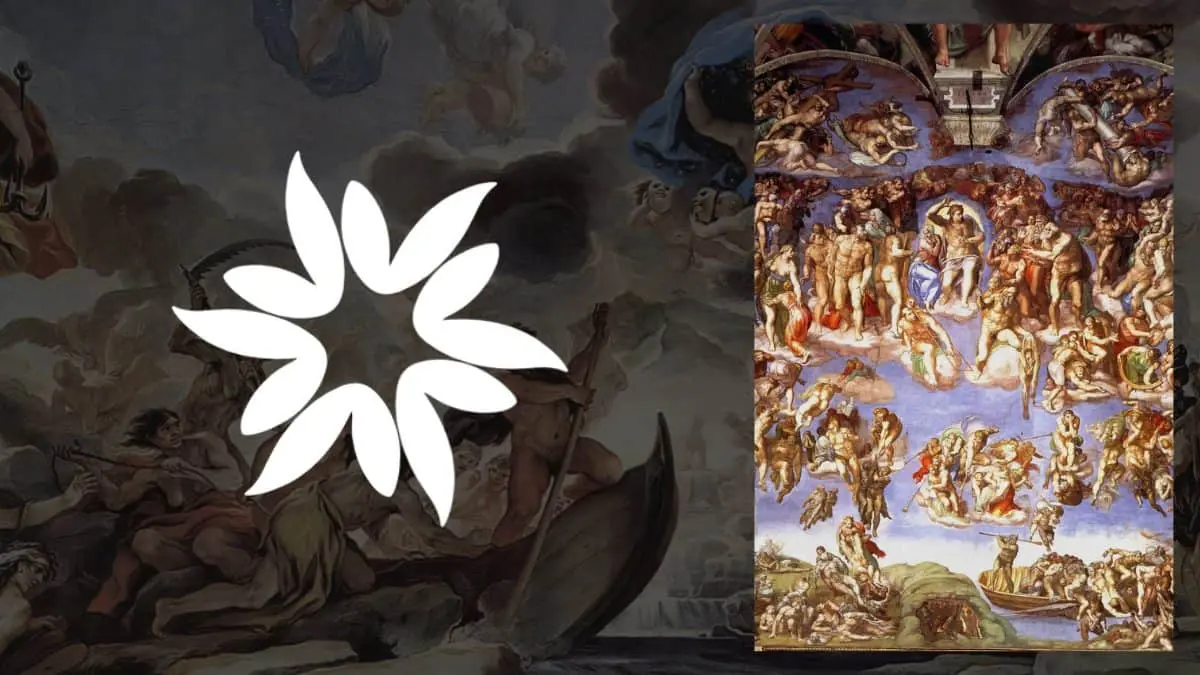Art has always been a powerful way to express ideas and make people think. Some artworks do more than just please the eye — they challenge our views and spark strong reactions.
These controversial pieces often tackle bold themes, contain shocking content, or showcase radical styles.
Key Takeaways
- These artworks push boundaries and question what’s considered normal, making people think differently about art and society.
- Each piece has sparked debates and strong emotions, showing the powerful impact art can have on viewers.
- Despite the controversies, these artworks have left a lasting mark on the art world, influencing future generations, and are still discussed to this day.
1. The Last Judgment by Michelangelo (1536-1541)
Michelangelo’s The Last Judgment is a grand fresco covering the altar wall of the Sistine Chapel in Vatican City. It portrays the Second Coming of Christ and the final judgment of souls.
The fresco is filled with over 300 dynamic figures, including saints, angels, and the damned.
The central figure is Christ, surrounded by saints like John the Baptist and Peter. Below Christ, the saved ascend to heaven, while the damned are dragged to hell by demons.
The painting was controversial due to its depiction of numerous nude figures, which many deemed inappropriate for a sacred space.
Critics like Biagio da Cesena, a papal master of ceremonies, felt the fresco was more suitable for public baths than a chapel.
The controversy led to the Council of Trent’s decision in 1564 to cover the nudity with draped fabrics.
The fresco reflects Michelangelo’s mastery of the human form and his innovative approach to religious art, merging classical mythology with Christian themes.
2. Fountain by Marcel Duchamp (1917)
Marcel Duchamp’s Fountain is a seminal work in the history of conceptual art.
This piece, a porcelain urinal signed R. Mutt, was submitted anonymously to the Society of Independent Artists’ exhibition in 1917.
Despite the society’s promise to exhibit all submissions, Fountain was rejected because it was indecent and not art, leading Duchamp to resign from the board in protest.
This act highlighted the arbitrary nature of what is considered art and challenged the art establishment to rethink its boundaries and definitions.
The name R. Mutt was a playful pseudonym derived from the Mott plumbing company and the comic strip characters Mutt and Jeff, adding layers of irony and humor.
Duchamp’s intention was to emphasize that art could be about ideas rather than aesthetic qualities.
By presenting a mass-produced object as art, he shifted the focus from the physical craftsmanship to the intellectual engagement with the piece.
3. Guernica by Pablo Picasso (1937)
Guernica is one of Pablo Picasso’s most powerful and politically charged works.
Created in response to the bombing of the Basque town of Guernica during the Spanish Civil War, the painting captures the horrors of war in a stark, monochromatic palette.
The chaotic scene is filled with fragmented, agonized figures, symbolizing the suffering inflicted by the conflict.
The painting was controversial for both its graphic content and its cubist style, which some found difficult to interpret.
It was meant to be a political statement condemning the violence and devastation of war.
Over time, Guernica has become an iconic symbol of anti-war sentiment and a testament to the impact of political art. Its exhibition history and the debates it spurred continue to highlight its significance in both art and political discourse.
4. Piss Christ by Andres Serrano (1987)
Piss Christ by Andres Serrano is a provocative photograph depicting a small plastic crucifix submerged in a container of the artist’s urine.
Created in 1987, this artwork became infamous for its controversial nature.
Serrano’s intent was not to blaspheme but to comment on the commercialization and cheapening of religious icons in modern culture.
Despite his personal Christian faith, Serrano wanted to provoke a rethinking of how sacred symbols are treated in contemporary society.
When first exhibited at the Stux Gallery in New York, the piece was well-received. However, controversy erupted when it was later displayed at the Southeastern Center for Contemporary Art in North Carolina, winning an award funded by the National Endowment for the Arts (NEA).
This government sponsorship led to backlash from conservative politicians, including Senators Al D’Amato and Jesse Helms, who argued that public funds should not support art they deemed offensive.
The controversy extended to debates over freedom of expression and the role of government in funding the arts.
Piss Christ has faced vandalism multiple times, including in 2011 in France when Christian protesters attacked it with hammers.
Despite — or perhaps because of — the uproar, the artwork remains a significant piece in discussions about the intersection of art, religion, and politics.
5. My Bed by Tracey Emin (1998)
Tracey Emin’s My Bed is a raw and personal installation that features her unmade bed surrounded by various personal items, including condoms, underwear, and empty bottles.
This work reflects a period of emotional turmoil in Emin’s life, symbolizing her vulnerability and distress.
Created in 1998, the piece was shortlisted for the Turner Prize, one of the most prestigious art awards in the UK.
The artwork sparked a wide range of reactions. Some praised it for its honesty and emotional depth, seeing it as a powerful statement on personal suffering and mental health.
Others criticized it as a sensationalist stunt, arguing that it challenged the boundaries of what could be considered art.
Despite the mixed reviews, My Bed has become a landmark in contemporary art, pushing the conversation about what constitutes art and the role of the artist’s personal experience in their work.
Emin’s work often explores themes of love, loss, and identity, and My Bed is a key example of her ability to transform deeply personal experiences into universal artistic expressions.
6. The Holy Virgin Mary by Chris Ofili (1996)
Chris Ofili’s The Holy Virgin Mary is a mixed-media painting that combines traditional religious iconography with contemporary elements.
It portrays a black Madonna adorned with elephant dung and surrounded by cutouts of female genitalia from pornographic magazines.
The background is a shimmering gold, reminiscent of Byzantine religious icons.
This artwork was part of the controversial “Sensation” exhibition at the Brooklyn Museum in 1999.
It was criticized heavily, with then-Mayor Rudy Giuliani calling it blasphemous and threatening to withdraw city funding from the museum.
Despite the outrage, the museum defended the artwork, emphasizing its commentary on racial and religious stereotypes. The controversy significantly raised Ofili’s profile in the art world.
7. Les Demoiselles d’Avignon by Pablo Picasso (1907)
Les Demoiselles d’Avignon is a groundbreaking painting by Pablo Picasso, completed in 1907.
It features five nude women with distorted and angular features, a style inspired by African masks and Iberian sculpture.
This painting marked a significant departure from traditional Western art forms and is often considered the first Cubist work, laying the groundwork for modern art.
Picasso worked on this piece for nine months, creating hundreds of sketches and studies. The painting was initially titled Le Bordel d’Avignon (The Brothel of Avignon), reflecting its depiction of prostitutes in a Barcelona brothel.
The provocative subject matter and radical style shocked viewers and critics when it was first exhibited in 1916.
Art critic André Salmon later changed the title to Les Demoiselles d’Avignon to reduce its shock value.
The painting’s fragmented and abstracted forms broke with the traditional representation of space and perspective, influenced by Paul Cézanne’s The Large Bathers and African art.
Picasso’s innovative approach to depicting the human form, using flat, jagged planes and multiple viewpoints, challenged the norms of beauty and realism in art.
The women in the painting confront the viewer directly, creating a sense of discomfort and immediacy.
8. The Guitar Lesson by Balthus (1934)
The Guitar Lesson by Balthus, painted in 1934, is one of the most controversial artworks due to its explicit and disturbing content.
The painting depicts a music teacher in a highly intimate and provocative pose with a young girl, which has led to widespread criticism for its portrayal of pedophilia.
This artwork is rarely displayed publicly due to its controversial nature.
The disturbing imagery overshadows discussions about its artistic merits, and it remains a deeply polarizing piece.
While some argue that it should be viewed as a commentary on power dynamics and sexuality, the graphic content makes it difficult for many to see beyond its provocative nature.
9. Self by Marc Quinn (1991)
Marc Quinn’s Self is a unique and provocative self-portrait made using the artist’s own blood.
Every five years, Quinn collects around ten pints of his blood over several months and uses it to create a cast on his head.
The resulting sculpture is then preserved in a frozen state using refrigeration equipment. This process shows the themes of self-identity, mortality, and the passage of time that are central to Quinn’s work.
The use of blood as a material makes Self a true literal self-portrait, incorporating a part of the artist’s own body.
This method draws attention to the fragility of life and our dependence on science and technology, as the sculpture must remain frozen to maintain its form.
Without electricity, the artwork would melt, symbolizing the delicate balance between life and death.
Self has been interpreted in various ways, ranging from a groundbreaking exploration of self-portraiture to a gruesome and shocking piece.
The initial sculpture was created during a period in Quinn’s life when he was struggling with alcoholism, adding a personal dimension to the work.
This dependency is mirrored in the sculpture’s reliance on electricity for preservation.
Quinn has continued to create new versions of Self every five years, each time using the same process.
This ongoing project not only documents his aging process but also maintains a dialogue about the nature of existence and the role of the artist in representing it.
10. The Dinner Party by Judy Chicago (1974-1979)
Judy Chicago’s The Dinner Party is a large feminist artwork celebrating women’s history.
It features a triangular table with 39 place settings, each honoring an important woman from history, from mythical figures like Ishtar and Kali to historical women like Eleanor of Aquitaine and Virginia Woolf.
Each setting has decorated china plates, many showing vulva shapes, and embroidered runners.
The artwork faced criticism for its explicit imagery and was initially deemed vulgar by some.
However, it is now seen as a significant work of feminist art, highlighting the contributions of women throughout history and challenging the male-dominated art world.
The Dinner Party is permanently displayed at the Brooklyn Museum in New York, where it continues to spark discussions about women’s roles and achievements.
Chicago’s work was groundbreaking for its collaborative approach and focus on women’s experiences and histories, often overlooked in mainstream stories.
The detailed craftsmanship and inclusion of so many important women make The Dinner Party a strong statement on recognizing and celebrating women’s contributions to culture and society.
Discover and Engage With More Controversial Art Masterpieces
These ten controversial artworks show how art can provoke deep thought, question norms, and spark intense debates.
From Michelangelo’s daring nudity in The Last Judgment to Duchamp’s redefinition of art with Fountain, each piece gives us new ways to see the world.
Look into the stories behind these bold artworks. Visit exhibits, read about them, and join conversations. Let these pieces inspire you to think differently and engage with the art around you.








